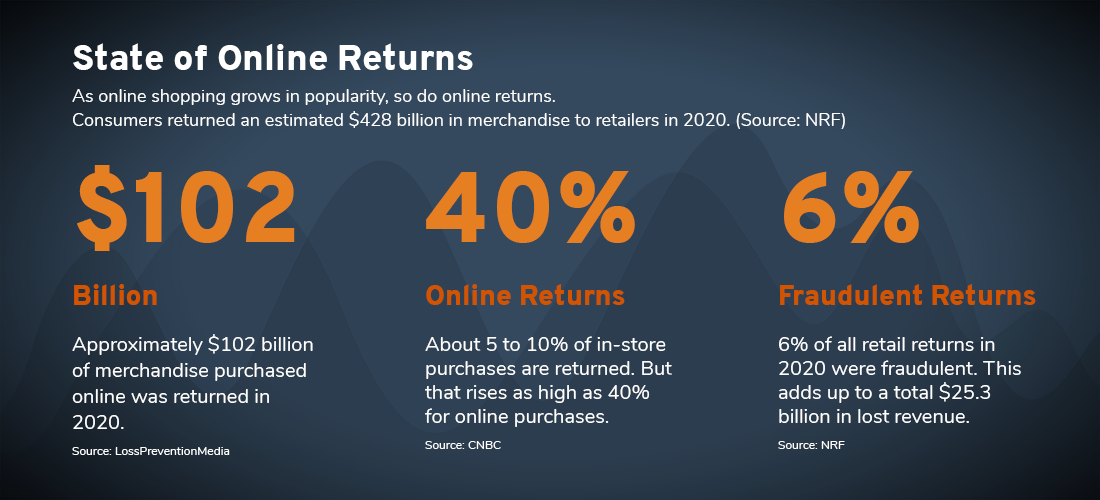An Explosion in Online Returns
The 2020 holiday season saw massive growth in ecommerce. According to Adobe Analytics, online shopping over the 2020 holidays in the US grew 32.2% from 2019s, totaling $188.2 billion. Also, online sales in November 2020 hit $100 billion for the first time ever. But, with the big spike in online sales, comes a big influx in returns. As was expected, the record setting shopping season brought about an all-time high in online returns.
According Chain Store Age, UPS had estimated a 23% increase in returns volume in the weeks following Christmas and the New Year. More specifically, UPS saw 1.75 million returns a day for the first week of 2021 for a record-setting total of 8.75 returned packages. Primarily driving this massive influx in returns is, of course, the huge increase in online shopping. The ever growing convenience of online shopping, along with new consumer demands such as curbside pick up continues to make the retail supply chain more complex. The explosive growth in online shopping and returns is obviously not just during the holiday season. In total, US ecommerce growth was up 44% in 2020. Now consider that items bought online are much more likely to be returned that items bought from a physical store. Via CNBC, Shoppers return 5 to 10 percent of what they purchase in store but 15 to 40 percent of what they buy online.
Make no mistake, the growth in online returns is not a trend. Retailers and manufacturers should expect these number to only grow as omnichannel shopping accelerates. With that said, retailers and manufacturers can also expect to feel a few growing pains. Approximately $102 billion of merchandise purchased online was returned, with $7.7 billion labeled as fraudulent.

How RFID Can Help Handle Returns Processes
To better serve its retail partners and customers, manufacturers and distributors need to reduce the friction with their supply chain. That’s where RFID comes in. Depending on how an RFID system is deployed, warehouse teams can expect to see improvements in supply chain productivity and inventory accuracy. Here are a few specific ways an RFID system can help improve the handling and processing of returns.
Reducing Shipping Errors
It sounds simple but one of the biggest ways shippers can improve its returns processes is by reducing the total amount of returns. How? By reducing shipping errors. There are several reasons why an item or items need to be returned. But, one avoidable reason is picking/ packing errors. According to Logistics Management, distribution centers in the US are losing an average of nearly $585,000 per year due to mis-picks. Additionally, incalculable amounts of time are lost in correcting picking/packing mistakes as well.
A simple RFID system can immediately impact any business. Once inventory is tagged, items are easily identified automatically by an RFID reader. RFID takes away all the guess work employees need to do. Mistakes go down exponentially, while order fulfillment times plummet. A strategic RFID deployment, such as Putting readers along conveyor belts and between dock doors can improve a shipping accuracy rate to as much as 99.99%.
Tracking Inventory Post Return
For most warehouses, low inventory accuracy is an issue that touches many areas of its operations – including the handling of supply chain hiccups such as online returns. In warehouses and distribution centers, returned goods can have a tendency to end up in a dark, forgotten area. It’s important to ensure goods are not left untouched for too long. Items left unshelved or not refurbished eats into profits and can hurt an operation’s inventory accuracy. Item level tagging inventory can solve this issue so that a returned item’s location and status can be tracked. Workers can get notified when returned items have been brought into the warehouse, and if the inventory has been left untouched for too long.
Conclusion
When considering solutions for online returns it’s important to weigh the benefits with the downsides. Many systems deployed to aid inventory management and returns processing can end up slowing down your operations. Handling the onslaught of incoming returns is challenging enough. Adding additional workflows such as reprinting labels and sorting goods manually may provide operational benefits, it can also bog down floor workers and ultimately slow things down. In order to bring real fixes to your supply chain in regards to online returns, logistics teams need solutions that can give a more granular view of their entire warehouse and inventory.















 RFID Cage
RFID Cage